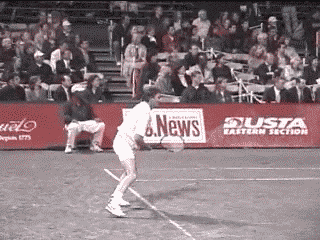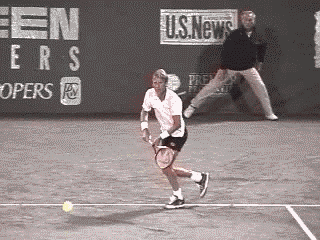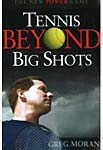| TennisOne Lessons Don’t “Play,” Practice Greg Moran Another summer has ended, exactly the same way as the previous three—a straight-set loss in the first round of the club championships. This was going to be your breakthrough year. No more silly unforced errors, lapses in concentration or third-set fatigue. You took the court against Bobby, a player you beat regularly, confidently popped the top off a fresh can of balls and began your road to the trophy. One hour later, you walked off a straight-set loser, and all you had to show for your efforts were a sore arm, a can of used balls and a "good match" comment from Bobby. To make matters worse, you know what Bobby really meant to say was "Ha! I've been playing two years less than you, and I won." Needless to say, you’re fuming. You go through the usual list of excuses that creep into everyone's mind immediately after a bad loss: "the sun was in my eyes, my racquet was strung too loose, he cheated, my pro stinks, etc..
While these rationalizations may make you feel better temporarily, by the time you've showered, reclaimed your racquets from the trash can and settled into your car for the ride home, you force yourself to face a somewhat disturbing fact. In the past three years your game has not improved one bit. You still can't consistently keep the ball in play, your backhand stinks and God forbid you miss your first serve, because your second serve. . . well, enough said. We’ve all gone through periods of frustration where we’ve felt that our games are struck in neutral. Tennis is a sneaky game, because improvement can initially come quickly. In many cases, someone who has just picked up a racquet and had a few lessons, can rally back and forth a bit, pop in 50 percent of his serves and begin playing the game. This "instant improvement" is seductive yet also deceptive. New players often feel that they'll continually improve at this rate, and within six months they’ll be clearing off space on their mantle for their trophies. While progress may come quickly initially, in order to move to the higher levels of the game you need to do more than come to the courts once or twice a week and play a few casual sets. That being the case, I’m happy to say that with a little effort and a good plan, it’s possible for every player to improve. Here are a few simple strategies that are sure to bring a smile to your face after next year’s championships. Take a Hard Look at Your Game What do you do well? What do you do poorly? If you lost ten pounds would you move around the court better? Below is a simple, skills inventory that you can use for yourself. It’s short and straight to the point. It should take you all of three minutes to go through. Write a sentence or two in each section dealing with your strengths and weaknesses. Be honest with yourself and focus on both your physical and mental games. Simply thinking about your game and jotting down a few notes is the first step towards making you a better player. Take the time! I’ve filled one out below as an example. Tennis Skills InventoryName: Greg Moran Write a few brief sentences in each section. This is for your own benefit, so you can see on which areas you need to work.
If you feel comfortable doing so, ask one of your playing partners to asses your game. Most players love to talk about tennis and will be happy to give you their thoughts--some even without you asking. This will give you a good idea of where you’re presently at and what you need to do to get where you want to go. Take to the Practice Court How many times per week do you practice your tennis skills? I don’t mean walking onto the court, hitting a few shots and then saying “Serve em up.” Practice means stepping onto the court with a specific plan to maximize your time and working on various aspects of your game. So I’ll ask you again, "How many times a week do you practice?" For many players, the answer is zero. Unless you’re a professional, tennis is not the top priority in your life, nor should it be. If you’re a junior player, there’s school, other activities, not to mention your social life, competing for your time. If you’re an adult, the pressures on you are even stronger. The time that you can set aside for tennis is at a premium, so when you do step onto the court, you want to hit as many balls as possible. Playing sets and matches seldom accomplishes this because the ball is generally in play for a short period of time.
Find another player who likes to “practice” and whose goals and ability are similar to yours. At least once a week, walk on the court with a specific plan and set of drills that will allow you to hit as many balls as possible (which is always more fun) and work on your game. When you walk on the court to practice do so with the same focus and intensity that you would if you were playing a tournament final. Chase down and hit every ball with energy and a purpose. Jimmy Connors was well known for his relatively brief yet incredibly intense practice sessions. Joel Drucker, author of the captivating book “Jimmy Connors Saved My Life” says that “When Connors practiced, the emphasis was on quality over quantity. That meant going for every ball on one bounce, playing balls that were out of the court, constantly moving his feet. You would never, ever see Connors stop in the middle of a rally, pick up a ball that bounced past the baseline and start the rally again, says Drucker. “Instead, he'd play balls from all corners, always moving.Rarely was he on-court longer than 90 minutes at a time. Rather than leave a court tired, he left it eager.” Try a Heart Rate Monitor I’ve recently begun to wear a heart rate monitor when I work out and have found that it works wonders as far as motivating me to keep up the intensity. The monitor, which fits around your chest will measure the intensity of your workout and give you a reading on a special watch you wear on your wrist. They give exact measurements and can tell you whether to pick it up or slow it down. It’s like having a personal trainer on the court with you. Polar makes the best that I’ve seen. Musicians practice their scales, doctors operate on hundreds of cadavers before they perform surgery on a living patient, and you need to hit thousands of crosscourt forehands in drills before you gain the confidence to pass your archrival with it in the club championships Here is a sample, one hour, practice program that will take you through all aspects of your game. Be sure to:
One Hour Practice Routine
Take this plan to the court and adjust the time to suit your needs. If, in your last match, you served great but your forehand gave you fits, spend additional time on your forehand and cut out the serving. Many players say that they find practicing “boring,” believe me, it is not nearly as boring as playing the same mediocre tennis year after year. What if I Don’t Have Anyone to Practice With? No problem. Track down a backboard. Bjorn Borg used one when he was learning the game and Jimmy Connors still uses one today. A backboard can be one of your most effective practice partners. It always wants to play, doesn’t get tired and never misses.
When I was a junior player, I once spent an entire winter playing in a program and never once stepped onto a tennis court. The program was conducted by Brian Eisner, the legendary former coach of the University of Michigan men’s team, and was held in a gymnasium. Eisner had different stations set up and we would practice hitting into various size squares of adhesive tape. Each week we were able to practice every stroke, refine our consistency and accuracy and hit thousands of balls. Most clubs and public parks have a backboard. If you can’t find one, try your local school or YMCA. They’ll usually let you use their gym. Here’s a 60-minute backboard program. Take approximately 10 steps from the wall. This should place you approximately 21 feet from the wall, the distance from the net to the service line. One Hour Backboard Program
Take Some Lessons A few sessions with a great teaching professional can go a long way towards jump starting your game. When you meet your pro for the first time, he’ll undoubtedly ask you two key questions: "What are your goals with your tennis,” and “how often are you able to play?” Show him your self-evaluation and tell him about your goals and how much time you can devote to improving. For some tennis players, their goal is to win more matches, while others simply want to get some exercise and learn to play well enough to enjoy tennis with their spouses.
After a lesson or two, the pro will have a good feel for your ability as well as your mental approach to the game. He’ll also have thoughts on what you need to change and add to your game to improve. At that point, the two of you can sit down and come up with a game plan for improvement. This plan will include both short and long term goals. Short term goals might be things like changing a grip, adding a new shot or getting fitter. Your short term goals should lead up to a long term goal such as team tryouts or a big match. As you conquer each of your short term goals you’ll get an injection of enthusiasm as you see your game improving. Every month or so sit down with your pro and evaluate your progress. Cross off the small goals you’ve attained and add new ones as you make your way to your larger goal of making the school or club team or performing well in the big tournament. Tennis lessons are not cheap, so each time you walk onto the court, have a specific idea of what you’d like to focus on. Ask questions and take advantage of the pro's knowledge. Otherwise you may wind up working on a little bit of everything and not enough of anything. Go to the USPTA or PTR website to look for certified pros in your area, or contact one of the fabulous professionals at TennisOne.com to take advantage of their new online lesson program. When you get in the car to drive cross country you map out a route. Do the same with your tennis. Take a few minutes to evaluate your game. Spend some time with a pro and hit the practice courts with a specific program and you’ll be well on your way down the road to reaching your potential. Your comments are welcome. Let us know what you think about Greg Moran's article by emailing us here at TennisOne.
Tennis Beyond Big Shots presents a bold back-to-the-future approach. A new game that moves away from power and big shots yet is more lethal to opponents than any booming serve. Greg Moran shows players of all ages and abilities that, with simple and small changes, you can not only maximize your tennis wins and play longer, but also have much more fun doing it. Click link to purchase Greg Moran's book, Tennis Beyond Big Shots. Mansion Grove House is pleased to announce that in May, 2008, they will release the second edition of Tennis Beyond Big Shots. Written by Greg Moran, the book (which includes a new chapter) was Amazon's #1 new tennis release in 2007. |





